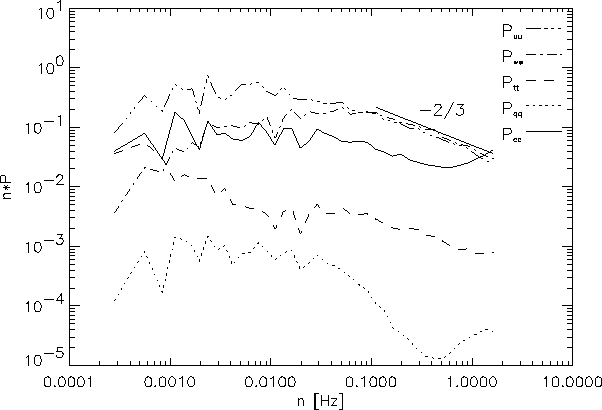As part of the quality assurance procedure applied, data values outside ±4![]() are removed from each hourly time series before the trend removal is performed
(Eugster et al., 1997). This despiking procedure uses the same linear trend
removal to determine the standard deviation of the dataset. This ensures the
homogeneity of the wind speed, temperature, water wapour mixing ratio and carbon
dioxide mixing ratio data filtering out the extreme values caused by instrument
error, precipitation, moisture or rime.
are removed from each hourly time series before the trend removal is performed
(Eugster et al., 1997). This despiking procedure uses the same linear trend
removal to determine the standard deviation of the dataset. This ensures the
homogeneity of the wind speed, temperature, water wapour mixing ratio and carbon
dioxide mixing ratio data filtering out the extreme values caused by instrument
error, precipitation, moisture or rime.
Spectral analysis is performed as a powerful tool for the quality check of the eddy covariance system and the measuring devices. The ideal turbulent signal has a well defined spectrum which can be approximated with each limited time series. The spectral analysis is performed with standard FFT routine (Stull, 1988; Matyasovszky, 1990).

|
Figure ![]() shows the power spectra of horizontal wind speed,
vertical wind speed, temperature, water vapor and carbon dioxide mixing ratio
as an average of two hourly spectra measured between 12h and 14h UTC+1 in 24
July, 1999. The average horizontal wind speed was 9.5 m s
shows the power spectra of horizontal wind speed,
vertical wind speed, temperature, water vapor and carbon dioxide mixing ratio
as an average of two hourly spectra measured between 12h and 14h UTC+1 in 24
July, 1999. The average horizontal wind speed was 9.5 m s![]() .
.
As natural frequency multiplied with the power spectra itself is plotted against natural frequency and both axes are logarithmic, the power spectra should ideally decrease linearly with a slope of -2/3 in the inertial subrange of the turbulent signal according to Kolmogorov's law (Kaimal et al., 1972). Also, the ideal shape of the power spectra is described in Kaimal et al. (1972). As it is described by Anderson and Verma (1984) and Ohtaki (1985), spectral similarity exists between the spectra of temperature, water vapor and carbon dioxide. This similarity means that the spectral and cospectral curves are similar in the ideal case.
It is evident from figure ![]() that all power spectra behaves
well except the spectra of the temperature fluctuations. As it was mentioned
above in the context of the mean removal time calculations (section
that all power spectra behaves
well except the spectra of the temperature fluctuations. As it was mentioned
above in the context of the mean removal time calculations (section ![]() ),
the temperature fluctuations exhibited an unusual behaviour. Now the damaged
power spectra gives the explanation: the thermocouple seems to act as a kind
of a high-pass filter. While the inertial subrange follows the -2/3 slope ideally,
the lower frequency signal (caused by the larger scale eddies) is damped between
0.001 and 0.1 Hz. This can be caused by the low heat capacity of the reference
box of the thermocouple, which means that the box follows the temperature of
the air filtering out the low frequency temperature fluctuations that still
contribute to the turbulent flux.
),
the temperature fluctuations exhibited an unusual behaviour. Now the damaged
power spectra gives the explanation: the thermocouple seems to act as a kind
of a high-pass filter. While the inertial subrange follows the -2/3 slope ideally,
the lower frequency signal (caused by the larger scale eddies) is damped between
0.001 and 0.1 Hz. This can be caused by the low heat capacity of the reference
box of the thermocouple, which means that the box follows the temperature of
the air filtering out the low frequency temperature fluctuations that still
contribute to the turbulent flux.
There is some noise in the inertial subrange spectra of water wapour and carbon dioxide at frequencies higher than 0.5 Hz. This noise has a random fashion and should not be correlated with the vertical wind speed. The same behaviour was observed by many scientists working with a LI-COR 6262 instrument (e.g. Grelle and Lindroth, 1996; Eugster et al., 1997).
The water vapor power spectra also exhibits some degradation in the inertial subrange, which is caused by attenuation of fluctuations and possibly by water condensation inside the air inlet tubes (B. Berger, pers. comm.). A methodology to reconstruct a damaged water vapor spectra can be found in Berger et al. (2001).

|
Figure ![]() shows the cospectra of vertical wind speed fluctuations
with horizontal wind speed, temperature, water vapor mixing ratio and carbon
dioxide fluctuations. The plot is constructed as an average of two hourly cospectra
measured in 24 July, 1999 between 13h and 15h, UTC+1. The average wind speed
was 9.3 m s
shows the cospectra of vertical wind speed fluctuations
with horizontal wind speed, temperature, water vapor mixing ratio and carbon
dioxide fluctuations. The plot is constructed as an average of two hourly cospectra
measured in 24 July, 1999 between 13h and 15h, UTC+1. The average wind speed
was 9.3 m s![]() .
.
Most of the cospectra exhibit correct behaviour, as they follow the -4/3 slope in the inertial subrange (Kaimal et al., 1972). The wT cospectra is clearly degraded, as it is expected from the power spectral plot. The degradation is most visible between 0.003 Hz and 0.03 Hz, where the cospectra actually crosses the water vapor cospectra caused by the degraded cospectral amplitude.
The water vapor cospectra drops faster than the expected -4/3 slope which means that there is a flux loss possibly caused by condensation in the tubes since the area under the cospetral curves are equal to the covariance (Stull, 1988). A part of the degradation is accounted for using the spectral correction routines described in the next subsection.